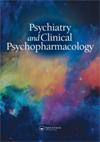聚焦超声脉冲对阿片类药物依赖大鼠伏隔核的影响
IF 0.5
4区 医学
Q4 PHARMACOLOGY & PHARMACY
引用次数: 2
摘要
背景:脑深部刺激(DBS)是目前唯一被证明对脑深部结构选择性刺激有效的方法。此前有报道称,通过DBS刺激在物质成瘾发病机制中起关键作用的伏隔核(NA)可有效治疗物质成瘾。目的:本研究的目的是通过无创聚焦超声(US)刺激大鼠NA,观察吗啡条件下位置偏好的变化,并检测US波是否会引起组织损伤。方法:采用无创低强度聚焦超声(LIFU)在场所条件反射模型中刺激大鼠NA。结果:在研究初期,我们使用吗啡诱导位置偏好。正如预期的那样,吗啡引起了显著的位置偏好。吗啡获得位置偏好后,我们将大鼠分为两组。一组接受LIFU波到NA,另一组只接受sham,即没有US波刺激。两组大鼠均继续接受吗啡治疗。然后,我们研究了LIFU和sham是否会降低吗啡诱导的位置偏好。我们观察到吗啡诱导的位置偏好在假药组持续升高,而超声组没有升高。虽然LIFU阻止了大鼠的提高,但它并没有引起吗啡偏好的显著降低。结论:我们认为有必要进一步研究低强度聚焦超声作为成瘾的替代治疗方式的效果。本文章由计算机程序翻译,如有差异,请以英文原文为准。
The effects of focused ultrasound pulsation of nucleus accumbens in opioid-dependent rats
ABSTRACT Background: Deep Brain Stimulation (DBS) is the only modality proven to be effective on selective stimulation of the deep brain structures. It was previously reported that, by using DBS, stimulation of nucleus accumbens (NA), a region that plays a pivotal role in the pathogenesis of substance addiction, is effective for the treatment of substance addiction. Objective: The purpose of the current study was to observe how the morphine-conditioned place preference changed in rats by stimulating NA with a non-invasive method, focused ultrasound (US) and to detect whether there would be any tissue damage caused by US waves. Methods: We used low-intensity focused ultrasound (LIFU), a noninvasive modality, in a place conditioning model to stimulate NA in rats. Results: At the initial stage of our study, we used morphine to induce place preference. As expected, morphine administration caused significant place preference. After the place preference was obtained by morphine, we divided the rats into two groups. One group received LIFU waves to NA and the other group received only sham, that is, no stimulation with US waves. Rats in both groups were continued to receive morphine. Then, we investigated whether LIFU and sham will reduce morphine-induced place preference or not. We observed that morphine-induced place preference had an ongoing raise in the sham group while no raise was detected in the ultrasound group. Although LIFU prevented the rats from the raise, it did not cause a significant reduction of morphine preference. Conclusion: We state that there is a need for future studies to investigate the effects of low-intensity focused ultrasound as an alternative treatment modality in addiction.
求助全文
通过发布文献求助,成功后即可免费获取论文全文。
去求助
来源期刊

Psychiatry and Clinical Psychopharmacology
Medicine-Psychiatry and Mental Health
CiteScore
1.00
自引率
14.30%
发文量
0
期刊介绍:
Psychiatry and Clinical Psychopharmacology aims to reach a national and international audience and will accept submissions from authors worldwide. It gives high priority to original studies of interest to clinicians and scientists in applied and basic neurosciences and related disciplines. Psychiatry and Clinical Psychopharmacology publishes high quality research targeted to specialists, residents and scientists in psychiatry, psychology, neurology, pharmacology, molecular biology, genetics, physiology, neurochemistry, and related sciences.
 求助内容:
求助内容: 应助结果提醒方式:
应助结果提醒方式:


